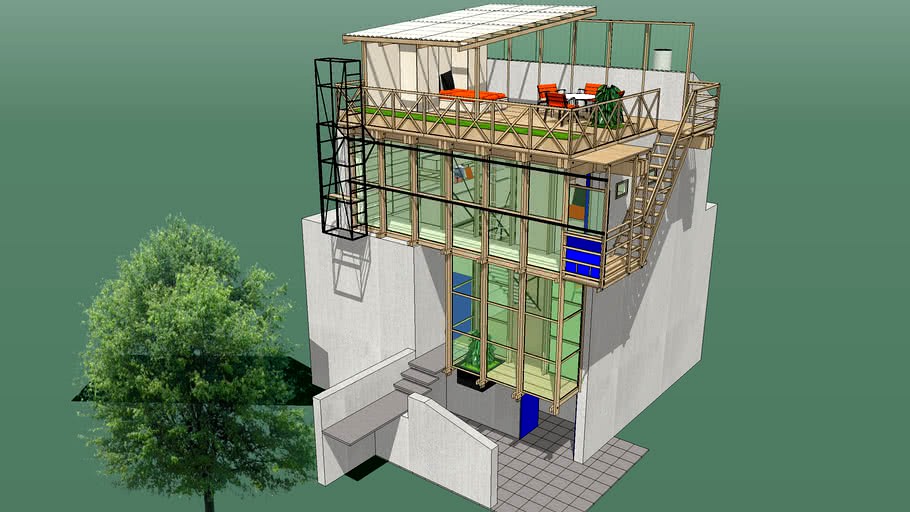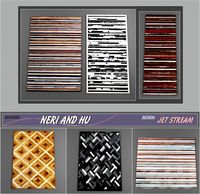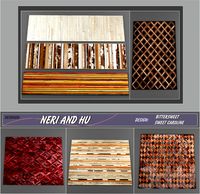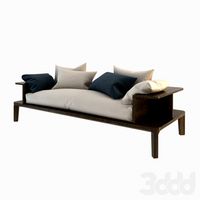3DWarehouse

Kube Hus Terje Moe
by 3DWarehouse
Last crawled date: 1 year, 9 months ago
This is my rendering of a famous house in a suburb of Oslo, Norway, designed and build by Terje Moe, a norwegian architect and engineer. I first saw this house in an article in the danish magazine 'Living Architecture' No. 1/1987, and haven't forgotten about it ever since, so naturally I had to make this. I've updated it with more interior, rebuild outer staircase, and adding the window-cleaning sledge, still need to do the steps leading up to the house from the road, but I haven't found any useful pictures/drawings of it. Text: 08/11/2015 by Roel Hofs The House: The house built on Bygdøy, Oslo, is a reverence to Terje Moe’s ideology of habitation. The ‘Kube hus’, as the house is called, was built in 1977. Moe constructed the building himself in one-year. Regarding this, he states: “Much of the work had to be done under bad weather conditions, but the experience of outdoor space gradually becoming indoor space with your own body, is I believe a lesson all architects should go through.”(Moe, 1982) Moe was an architect and an engineer. He had his own office for brief period, from 1970-1976, but mainly taught as professor at the Norwegian Institute of Technology and at the Oslo School of Architecture and Design. The Site: The site is a small plot squeezed in between the big plots of Bygdøy. The size is approximately 10 by 30 meters and has an elevation of 12 meters. The elevation makes the site face north. The House: The building finds its measurements in the difficulty of the site. Building his own house, Moe tried to solve what in his eyes was the malfunction of the contemporary housing of the time. Families in those houses live in separate rooms, which are secluded from the shared functions. He wanted to create a building, which solved this problem and created a social awareness of the people you are living with. The Base: The foundation for the building is the concrete block shell, which partly digs into the slope. Moe states that there is 3-piece realm in architecture: The first realm is the earth, which is this base. The second is the so-called ‘Midgard’ the place where people live. The last realm is the heaven, which is translated in the roof terrace. The Canopy: The wood structure placed on the base, encloses the living space. It is as Moe says: ‘the raincoat’ of the house and defines the space inside. It should create a sense of togetherness and a participation of the family business, living in this space. The Rooms: The rooms created in the house are either pushed away underground against the shell or hanged from the wooden canopy. By doing so the main space retains openness and the cubical measurements Moe wanted to achieve. Even the stairs are built as transparent as possible. The Merger: All different spaces are visually connected with the main downstairs space to encourage the members of the family to stay in this common room. The ground floor, the main living space, is this multipurpose area where the family comes together. It functions as a dining room, a living room and workshop. The workshop can be pulled out of one of the side rooms. The idea of multi-functional rooms could have easily come from his collaboration with Arne Korsmo. The Roof: The roof is the last part of the 3-piece realm, the heaven. The family lives on the roof 6 months of the year. A transparent sheet is placed over a part of the terrace to protect the family members against the harsh Norwegian summers. It also enables you to watch the stars when sleeping in the beds on the roof. Thank you to all contributors! #affordable #architect #Arne_Kosmo #bathroom #bedroom #cube #elevation #glass #hanging #hill #kitchen #loft #Norway #Oslo #roof #skylight #sustainable #Terje_Moe #terrace
Similar models
3dwarehouse
free

A new modern house from the company, Martinez Cruise Design Hus!
...use drawed in honor of rade urosevic and his family.. real size! #martinez_cruise_design_hus #modern_house #norway #rade_urosevic
3dwarehouse
free

Royal Palace, Oslo, Norway
...est of oslo. the palace has 173 rooms. #19th_century #design #langli #langli_design #norge #norway #norwegian #oslo #royal_palace
grabcad
free

Terrace Norway
...terrace norway
grabcad
a not so unusual design of an norwegian terrace
3dwarehouse
free

Regjeringsbygget
...regjeringsbygget
3dwarehouse
the highrise building for the norwegian government #government #highrise #norway #oslo #regjering
3dwarehouse
free

Pool with terrace
...designed for a house in norway. it designed with modern norwegian style. the pool also have a nice terrace. #pool #pools #terrace
3dwarehouse
free

Building in 0890 Oslo, Norway
...building in 0890 oslo, norway
3dwarehouse
architect model
3dwarehouse
free

Modern house
...use
modern house in norwegian scenery #bauhaus #building #home #house #living #mansion #modern #nature #norway #residence #villa
3dwarehouse
free

Family Nexus House
...ow awning type windows just below the roofline. a tripled window mullion element is seen in many rooms to create visual richness.
cg_trader
$7

Oslo 2 Seater Sofa
...by norwegian duo anderssen & voll (formally of norway says). made in norway and upholstered in denmark using kvadrat fabrics.
cg_trader
$7

Oslo 3 Seater Sofa
...by norwegian duo anderssen & voll (formally of norway says). made in norway and upholstered in denmark using kvadrat fabrics.
Terje
3d_export
$22

ekstrem chair by terje ekstrom
...ekstrem chair by terje ekstrom
3dexport
ekstrem chair by terje ekstrom
3ddd
$1

IKEA / TERJE
...tobucket.com/albums/r13/yarchi/renderterje1.jpg http://i140.photobucket.com/albums/r13/yarchi/renderterje2.jpg
turbosquid
$19

Round Kitchen Table IKEA TERJE Chairs
... available on turbo squid, the world's leading provider of digital 3d models for visualization, films, television, and games.
3d_sky
$8

IKEA / TERJE
...ikea / terje
3dsky
terje ikea chair
3d_sky
free

IKEA Terje
...ikea terje
3dsky
chair folding chair ikea
folding chair ikea terje color - black
3d_sky
free

Ikea Terje
...ikea terje
3dsky
ikea
textures are present
3dbaza
$4

Ikea TERJE folding chair (168193)
...ikea terje folding chair (168193)
3dbaza
ikea terje folding chair 3d model
thingiverse
free

IKEA Terje Dual Hook by fulafisken
...ikea terje dual hook by fulafisken
thingiverse
wall hanger for ikea terje folding chairs.
thingiverse
free

IKEA Terje Wall Hanger by fatihgol
...ikea terje wall hanger by fatihgol
thingiverse
wall hanger for ikea terje folding chair.
3d_sky
free

Ikea chairs "Terje"
...ikea chairs "terje"
3dsky
chairs ikea terje
ikea chairs "terje"
Kube
3ddd
$1

Karisma Kube
...karisma kube
3ddd
karisma , kube
книжки чужие, в сценке их нет)
evermotion
$10

CASAMANIA KUBE AM72
...nia design with all textures, shaders and materials. it is ready to use, just put it into your scene.. evermotion 3d models shop.
turbosquid
$79

Outdoor garden terrace furniture. Kube Code EM9 - Ego Paris
... available on turbo squid, the world's leading provider of digital 3d models for visualization, films, television, and games.
3ddd
$1

kube chair armchair lounge
...s, finition vinyle ou toile outdoor
structure/table en aluminium laquée, accoudoirs teck ou corian
motif fleur ou orient
thingiverse
free

kubes by miketulen123
...kubes by miketulen123
thingiverse
kubes
3d_sky
free

Kube Ma
...kube ma
3dsky
manufacturer: unknown. model: kube ma.
thingiverse
free

Kube coaster
...
approved by captain kube himself.
at the request of captain kube i also added a coaster holder that can hold up to 4/5 pieces.
thingiverse
free

Boxseez Kubes
...he all-in-one boxseez . . . . the kubes (cubes).
another addition to the family.
please enjoy.....
3d_sky
free

Karisma Kube
...karisma kube
3dsky
karisma
books of others, they are not in the scene)
thingiverse
free

Boxseez Kubes 3# by Kubie
...boxseez kubes 3# by kubie
thingiverse
part 3 of the kubes...... sometimes you just need a smile.
please enjoy
Moe
turbosquid
$2

MOE'S
...
turbosquid
royalty free 3d model moe's for download as on turbosquid: 3d models for games, architecture, videos. (1330547)
3d_export
$10

moes pub
...moes pub
3dexport
moe's bar, the simpsons.
turbosquid
free

Moe's Tavern
... available on turbo squid, the world's leading provider of digital 3d models for visualization, films, television, and games.
3d_export
$89

Moe Szyslak 3D Model
...ge bart matt groening cartoon toon serie tv rigged rig animation skin biped character
moe szyslak 3d model fabelar 38498 3dexport
cg_studio
$79

Moe Szyslak3d model
...ak3d model
cgstudio
.3ds .c4d .max .obj - moe szyslak 3d model, royalty free license available, instant download after purchase.
turbosquid
$1

LCD-Moe.3DS
... available on turbo squid, the world's leading provider of digital 3d models for visualization, films, television, and games.
3d_ocean
$15

Low poly Moe's bar
...amp;#x27;s polygonal pub render simpsons the simpsons vegetables
low poly moe’s bar,modeled on cinema4d r16,rotation is animated.
3d_export
$39

Moes Home Wheel Round Dining Table in Orange 3D Model
...home wheel round dining table in orange 3d model download .c4d .max .obj .fbx .ma .lwo .3ds .3dm .stl radionovas1 107716 3dexport
archive3d
free

Airplane 3D Model
...airplane 3d model archive3d airplane aeroplane amphibian airplane amphibian moe be-200 n170211 - 3d model (*.gsm+*.3ds) for exterior 3d...
3d_export
$35

Candy Chan 3D Model
...candy chan 3d model 3dexport anime moe cute girl animated rigged cool best naruto bleach cudly...
Hus
3ddd
$1

Chair Hus
...chair hus
3ddd
hus
hus chair
materials: sit & back plush green legs wood
3ddd
free

NERI AND HU
...neri and hu
3ddd
ковер
ковры ручной работы дизайнеров neri and hu
серия jet stream
3ddd
$1

NERI AND HU часть 2
...neri and hu часть 2
3ddd
ковры
ковры ручной работы дизайнеров neri and hu
серия bittersweet и sweet caroline
turbosquid
free

NERY&HU Armchair
... available on turbo squid, the world's leading provider of digital 3d models for visualization, films, television, and games.
3ddd
$1

Neri & Hu Platform Sofa
...кстуры.
вес 236 000 полигонов
сайтhttp://www.thefutureperfect.com/designer/neri-hu/platform-sofa.html
размеры 230х92см
turbosquid
$24

Capo dinning chair Neri & Hu
...3d model capo dinning chair neri & hu for download as max on turbosquid: 3d models for games, architecture, videos. (1579750)
turbosquid
$24

Shaker Dining Chair Neri and Hu
...er dining chair neri and hu for download as max, max, and obj on turbosquid: 3d models for games, architecture, videos. (1545645)
turbosquid
$7

Neri and Hu 777 Drape Desk
...odel neri & hu 777 drape desk for download as max and fbx on turbosquid: 3d models for games, architecture, videos. (1197441)
cg_studio
$79

Grumman HU-16 Albatross3d model
....lwo .ma .max .obj .xsi .c4d - grumman hu-16 albatross 3d model, royalty free license available, instant download after purchase.
turbosquid
$24

Duet Chair Upholstered Neri and Hu
...r upholstered neri & hu for download as max, max, and obj on turbosquid: 3d models for games, architecture, videos. (1553139)
